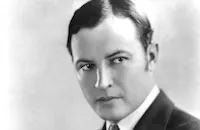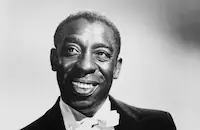White Zombie

Brief Synopsis
Cast & Crew
Victor Halperin
Bela Lugosi
Madge Bellamy
Joseph Cawthorn
Robert Frazer
John Harron
Film Details
Technical Specs

Synopsis
On their arrival in Haiti, Neil Parker and Madeleine Short, a young couple, take a coach that passes a funeral in which the body is being buried in the road. That night, they are followed by several eerie figures who, their coachman informs them, are zombies. He explains that the dead are buried in the road in hopes that the many passers-by will prevent the body from being exhumed and turned into a zombie. As their coach passes him while he is standing in the road, "Murder" Legendre, owner of the local sugar mill that employs the zombies, snatches Madeleine's scarf. Neil and Madeleine arrive at the home of the wealthy Charles Beaumont, whose desire for Madeleine prompts him to ask Murder for supernatural assistance, although he has invited her and Neil to be married in his house. Because Murder looked deeply into Madeleine's eyes while she was in the coach, he knows her love for Neil is true and unwavering, and his only solution for Charles is to transform Madeleine into a zombie. Charles is horrified by this alternative, but takes the potion given to him by Murder.
During the wedding ceremony, Charles entreats Madeleine to leave Neil, but to no avail. Shortly after the wedding, Madeleine, having been given the potion, apparently drops dead and is buried, only to be disinterred by Murder and Charles and brought back to life as a zombie. Neil, who in a distraught and drunken state sees apparitions of Madeleine, seeks the assistance of a missionary, Dr. Bruner. Bruner consults with a witch doctor who is the only man known to have left Murder's fortress alive. The doctor, however, refuses to become involved. Neil and Bruner then journey to Murder's castle and camp on the beach below the cliffs. As Neil suffers from a tropical fever, Bruner approaches the castle alone, but later, images of Madeleine awaken Neil and he, too, enters the castle.
Charles, meanwhile, regrets Madeleine's transformation and begs Murder to return her to life, but Murder has his own ideas for Madeleine, who is completely under his control, and refuses. Charles realizes to his horror that he, too, has been tainted by the potion and is slowly being transformed into a zombie. When Neil enters the fortress, Murder senses his presence, and after Neil collapses, Murder silently orders Madeleine to kill him. Unaware of her own actions, Madeleine approaches Neil with a knife, but Bruner grabs her hand from behind a curtain, and she drops the instrument and walks away. Neil awakens and follows Madeleine to the cliff, and Murder commands his zombies to kill Neil. Bullets do not stop the zombies, but when Bruner knocks Murder out, the zombies topple off the cliff to their deaths.
Murder awakens and eludes Neil and Bruner until Charles, who has recovered some of his motor capabilities, pushes Murder off a cliff. The fall kills Murder, and Charles is unable to regain his balance and falls to his death as well. Murder's death releases Madeleine from her stupor and she is restored to Neil.

Director

Victor Halperin
Cast

Bela Lugosi

Madge Bellamy

Joseph Cawthorn

Robert Frazer
John Harron

Brandon Hurst
George Burr Macannan
Frederick Peters
Annette Stone
John Printz
Dan Crimmins
Claude Morgan
John Fergusson
Velma Gresham

Clarence Muse
John Peters
Crew
Harold Anderson
Carl Axcelle
Ralph Berger
Clarco
L. E. Clark
William Cody
Herbert Farjeon
Herbert Glazer
Edward Halperin
Sidney Marcus
Arthur Martinelli
Harold Mclernon
Abe Meyer
Jack Pierce
Conrad Tritschler
Garnett Weston
Guy Bevier Williams

Photo Collections
Videos
Movie Clip



Trailer
Hosted Intro
Film Details
Technical Specs

Articles
White Zombie
As Murder Legendre, Lugosi is evil personified. He plays the owner of a sugar mill in Haiti who controls an army of zombie workers. When he becomes enarmored of a young bride-to-be (Madge Bellamy) who is visiting a neighboring estate, Legendre resorts to black magic to make her his own. The apparent model for this role and his dramatic interpretation of Count Dracula was a character Lugosi had portrayed in his first German film, Slave of a Foreign Will (Sklaven Fremdes Willens) in 1919. In it, he played a hypnotist with the mesmerizing power of Svengali.
Long considered the first Hollywood production to feature zombies, White Zombie was inspired by The Magic Island, William B. Seabrook's 1929 book on Haitian voodoo. The Halperin Brothers (Victor directed, Edward produced) also borrowed elements from Kenneth Webb's 1932 New York stage play, Zombie. (In fact, Webb tried, unsuccessfully, to sue the brothers for copyright infringement.) Besides the coup of casting Lugosi in the lead, the Halperin Brothers also hoped to revive the career of former silent star Madge Bellamy in the role of the female lead, Madeline Short.
The film was shot on the RKO-Pathe lot in Culver City and at Universal City. One of the sets from Cecil B. DeMille's epic, The King of Kings (1927), was used for Legendre's mountaintop veranda and castle interiors were assembled from parts of the Dracula and Frankenstein sets. The creepy zombie makeup was devised by Carl Axcelle and Jack Pierce of Universal who transformed Boris Karloff into The Mummy (1933) and other famous monsters. Another unique contribution was the innovative use of music arranged by silent picture maestro Abe Meyer. Some terrifically weird effects are achieved using native drumming, chants, and natural sounds. Even a Spanish jota composed by Xavier Cugat is used for one haunting sequence where John Harron (Neil Parker) pursues an apparition that looks like his bride.
The critics were particularly hard on White Zombie during its initial release and found it embarrassingly outdated and old-fashioned by current standards, citing the silent-era style of acting and Victorian era dialogue as examples. Seen today, White Zombie has the look of a gothic fairytale and can be viewed as a precursor to the works of Val Lewton with its heavy emphasis on atmosphere and sound. What most people don't realize is how much creative control Lugosi had over the project. His co-star, Clarence Muse, later stated that Lugosi rewrote, restaged and even directed some scenes making it unclear how much of the finished film reflects his influence.
Director: Victor Halperin
Producer: Edward Halperin
Screenplay: Garnett Weston (based on The Magic Island by William Seabrook)
Cinematography: Arthur Martinelli
Editing: Harold McLernon
Art Direction: Ralph Berger, Conrad Tritschler
Cast: Bela Lugosi (Murder Legendre), Madge Bellamy (Madeline Short), John Harron (Neil Parker), Joseph Cawthorn (Dr. Bruner), Robert Frazer (Charles Beaumont), Clarence Muse (coach driver).
BW-67m.
By Jeff Stafford

White Zombie
Quotes
Just give me a month. One little month!- Charles Beaumont
But there must be another way.- Charles Beaumont
There is no other way!- Legendre
Driver, who were those men we saw?- Madeline
They are not men, madame. They are dead bodies!- Coach Driver
Trivia
The play "Zombie" opened in New York in February, 1932, and the author, Kenneth Webb, sued the Halperins for the movie rights. However, the Halperins won the case.
The film was thought lost until its rediscovery in the 1960s. A court battle was fought between film distributor Frank Storace and the estate of Stanley Krellberg, the copyright owner of the film. Storace had wished to produce a restored version of the film but the estate refused him access to original footage in their possession. By the time Storace had given up the court battle, the footage had disintegrated, meaning it is lost forever.
Notes
A modern source includes the following credits: Asst to prod, Sidney Marcus; Orig mus, Guy Bevier Williams, Xavier Cugat; Addl mus, Nathaniel Dett, Gaston Borch, Hugo Riesenfeld, Leo Kempenski, Hen Herkan, H. Maurice Jacquet; Op cam, J. Arthur Feindel; and Assistant Camera, Charles Bohny and Enzo Martinelli. Modern sources provide the following additional information about the production: Kenneth Webb, author of the play Zombie (New York, February 1932) sued the Halperins for the movie rights to the film, but the Halperins won the case. The film cost approximately $50,000 to produce, was funded by the New York firm Amusement Securities Corp., and was filmed at RKO Pathé and Universal Studios. According to actor Clarence Muse, some scenes were rewritten in part by Bela Lugosi, and he helped direct some retakes. Muse also noted that although another actor was originally hired to play the coach driver, Muse replaced him. Some footage of the previous actor's work was used in the film, however, that actor has not been identified. Modern sources note that Halperin Productions' 1936 sequel Revolt of the Zombies contained some footage from this film.

Miscellaneous Notes
Released in United States 1932
Released in United States July 1932
Released in United States 1932
Released in United States July 1932 (Shown at FILMEX: Los Angeles International Film Exposition (UCLA Archives Tribute: The Films of 1932) July 5-20, 1984.)
















